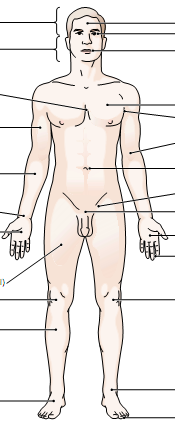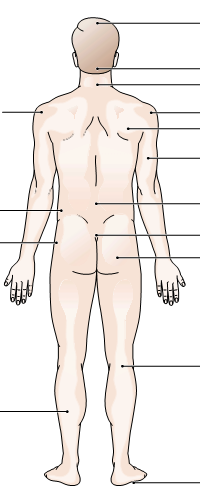
- •Contents
- •Unit 1 body structure
- •Body parts – categories
- •Vocabulary – 2
- •Анатомія людини
- •Glossary English-Ukrainian
- •Ukrainian-English
- •Unit 2 cells
- •Vocabulary – 2
- •Цитологія
- •Vocabulary – 3
- •Cell Structure
- •Vocabulary – 4
- •Клітинна теорія
- •Vocabulary – 5
- •Cell division
- •Glossary English-Ukrainian
- •Ukrainian-English
- •Unit 3 tissues
- •Vocabulary – 2
- •Тканини
- •Vocabulary – 3
- •Vocabulary – 4
- •Регенерація
- •Vocabulary – 5
- •Histology
- •Glossary English-Ukrainian
- •Ukrainian-English
- •Unit 4 organs and organ systems
- •Vocabulary – 2
- •Системи органів
- •Vocabulary – 3
- •Transplantation
- •Vocabulary – 4
- •Artificial heart
- •Glossary English-Ukrainian
- •Ukrainian-English
- •Unit 5 blood
- •Vocabulary – 2
- •Vocabulary – 3
- •Immune response
- •Blood Types
- •Vocabulary – 4
- •Blood Transfusion
- •Vocabulary – 5
- •Glossary English-Ukrainian
- •Ukrainian-English
- •Unit 6 the cardiovascular system
- •Vocabulary – 2
- •Vocabulary – 3
- •Vessel Heart disease
- •Vocabulary – 4
- •Кола кровообігу людини
- •Vocabulary – 5
- •Heart imaging
- •Glossary English-Ukrainian
- •Ukrainian-English
- •Unit 7 the vascular system
- •Intestine
- •Veins The Circulatory System
- •Vocabulary – 2
- •Серцево-судинна система людини
- •Vocabulary – 3
- •Vital Functions of the Circulatory System
- •Glossary English-Ukrainian
- •Ukrainian-English
- •Unit 8 the lymphatic system
- •Vocabulary – 2
- •Blood vessels
- •Inner lining
- •Pathogens
- •Connstituents of Lymph and Lympathic System
- •Vocabulary – 3
- •Vocabulary – 4
- •Infected Lymph Node
- •Glossary English-Ukrainian
- •Ukrainian-English
- •Unit 9 the respiratory system
- •Vocabulary – 2
- •Дихальна система
- •Vocabulary – 3
- •Inspiration
- •Intercostal muscles
- •Ventilation Breathing
- •Vocabulary – 4
- •Дихання
- •Vocabulary – 5
- •Artificial Respiration
- •Glossary English-Ukrainian
- •Ukrainian-English
- •Unit 10 the nervous system
- •Vocabulary – 2
- •Vocabulary – 3
- •Intermediate nerve cells
- •Involuntary response
- •Vocabulary – 4
- •Vocabulary – 5
- •Disorders of the Nervous System
- •Glossary English-Ukrainian
- •Ukrainian-English
Contents
Unit 1. Body Structure. ………………………………………………… 4
Unit 2. Cells. …………………………………………………………… 10
Unit 3. Tissues. ………………………………………………………… 20
Unit 4. Organs and Organ Systems. .…………………………………… 30
Unit 5. Blood. ………………………………………………………….. 38
Unit 6. The Cardiovascular System. …………………………………… 48
Unit 7. The Vascular System. ……..…………………………………… 59
Unit 8. The Lymphatic System. ………………………………………… 64
Unit 9. The Respiratory System.………………………………………… 71
Unit 10. The Nervous System. ..………………………………………… 80
Reference Literature 92
Unit 1 body structure
Exercise 1. Read and translate the text.
|
Human anatomy (1) can be precisely defined as a basic medical science, which deals with the scientific study of morphology of human body. In simpler words, human anatomy is the study of structure of human body. There are two main levels of structure of human body: macroscopic level (2) and microscopic level (3). For each of the two levels, there is a separate subdivision of anatomy. The one dealing with macroscopic level is known as gross anatomy (4) and the other which deals with microscopic level is called microscopic anatomy (5) or histology (6). Human gross anatomy is the examination of body structures that can be seen without a microscope. There are two approaches for gross anatomy: regional approach (7) and systemic approach (8). Regional anatomy (9) (topographical anatomy (10)) is the method of studying the body by regions (11), such as the thorax (12) and abdomen (13). In regional approach, human body is divided into regions like arm, forearm, wrist etc and all structures within that region are studied simultaneously. Systemic anatomy (14) is the method of studying the body by systems. The body is divided into organ systems (15) such as skeletal system (16), muscular system (17), nervous system (18) etc and structures belonging to one system are studied together. Histology or microscopic anatomy is the study of the structure of various organs (19) and tissues (20) of human body under a microscope. |
1. анатомія людини 2.макроскопічний рівень 3.мікроскопічний рівень 4.макроскопічна анатомія 5.мікроскопічна анатомія 6.гістологія 7.регіональний підхід 8.системний підхід 9.регіональна анатомія 10.топографічна анатомія 11. ділянками тіла 12.грудна клітка 13.черевна порожнина 14.систематична анатомія 15.системи органів 16.скелетна система 17.м’язова система 18.нервова система 19.органи 20.тканини
|
Exercise 2. Translate into English.
Будова людського тіла; вивчати будову людського тіла по системах; зап’ясток; людське тіло; морфологія людини; наукове дослідження; неозброєним оком; передпліччя; підрозділ; фундаментальна медична наука.
Exercise 3. Study the following figures and do the exercises below.
Figure 1. Common terms for body Figure 2. Common terms for body
regions, anterior view. regions, posterior view.


1 3 1
4
2 5 2
3
6 7 4 5
8 6
9 7 10
11 12 8 9
13
14 15 10 11
12 16 17
18
19
20 21 13
22
14
23 24
25 15
Exercise 4. Label the anterior view of the body regions with the terms below.
Ankle; arm; armpit; breast; chest; cranium; eye; face; fingers; foot; forearm; forehead; groin; hand; head; inner elbow; knee; kneecap; leg; lower extremity; mouth; navel; palm; pubis; thigh; toes; upper extremity; wrist.
Exercise 5. Label the posterior view of the body regions with the terms below.
Arm; back of knee; base of skull; buttock; calf; crown; deltoid; flank; hip; neck; sacrum; shoulder; shoulder blade; small of back; sole of foot.
Exercise 6. Fill in the table.
